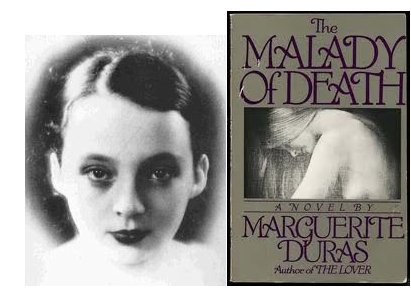Duras & the cinematic novel
The poet's novel

The first thing you might notice about The Malady of Death is the visual components to this book. It is slim, only sixty pages of text, like many volumes of poems. On each page the font size is larger than most large-print editions of books. I measure the opening capitol “Y” beginning “You” at one-half of a centimeter. The page that appears the fullest contains one-hundred and sixteen words. A page appearing one of the sparest contains sixty words. Section breaks appear as multiple paragraph breaks, a multitude of white space, and an occasional asterisk.
The two characters in this text are referred to only as “you” and “she.” This is a story told in particulars by nobody named. Or I should say, this is a non-story, a story about the inability to happen. The characters are present only in relation to desire or a lack of desire. This poet’s novel is a fable of sexual deadness, numbness, told in a very compressed episodic manner. A man approaches a woman, asks if he can pay her to spend many nights with him. She is to be passive, silent. He is hoping to discover if he has the ability to love. “She,” though she speaks little and is mostly asleep, is able to diagnose his “malady of death.” Though sexuality is often a subject in works by Duras, the real focal point is usually the question: what happens to a human being that renders them incapable of intimacy? Often the answer is war, but the focus is never war, but its psychological remains.
What is Duras’ influence on contemporary poets? On the novel? This is one vein to consideration of the form — the realm of a novelist and her particular influence. Poet and novelist Jeanne Hueving writes, “Marguerite Duras has greatly influenced my poetics because of her sense of being ravished and because of the synthesized mixture in her writing of perception and medium — of filmic seeing, framed documentation,and fictional apparatus. Her two “novels,” The Ravishing of Lol Stein and The Lover comprise an inquiry into female love and sex like no other.”[1]
Duras was one of the first modernist writers I read who wrote openly about women’s sexuality in a manner in which the unsaid was as essential as the said. Cinematically, one can see her texts. At the end of The Malady of Death instructions are given for a theater or film version of the work. These notes are as interesting as the text itself, in that they change how one reads the book and illuminate how Duras conceives of her text. She suggests that the piece could be staged, with the “young woman of paid nights” [2] lying on white sheets on a bed. She later adds notes regarding the text being filmed:
“If I ever filmed this text I’d want the weeping by the sea to be shot in such a way that the white turmoil of the waves is seen almost simultaneously with the man’s face. There should be a correlation between the white of the sheets and the white of the sea. The sheets should be a prior image of the sea.” [3]
This metaphoric process is movement akin to a poem. Duras tells the reader in her notes on staging that the man in the story should never appear. Instead, another man reads (does not perform from memory) the text. In this way Duras suggests that the central male character does not actually exist in her text. After reading this note one’s sense of the work is entirely changed. The main character, speaking most of the text, is an instance of absence. Duras has written absence into the center of the text in a way in which only becomes apparent once one has finished reading. The reader is required to rethink the experience of the text. Instead of moving forward, from beginning to end, as in most fiction, this text sends us back to the beginning.
Duras also connects the white space on the pages of the text to time and silence. She writes “There should be great stretches of silence between the different paid nights, silences in which nothing happens except the passage of time.” [4].
Notes:
1. Jeanne Hueving, conversation via email, Feb 2013.
2. Marguerite Duras, The Malady of Death, trans. Barbara Bray (New York, Grove Press, 1986), 56.
The poet's novel